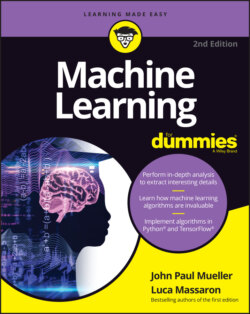Читать книгу Machine Learning For Dummies - John Paul Mueller, John Mueller Paul, Luca Massaron - Страница 24
Considering AI and Machine Learning Specifications
ОглавлениеAs scientists continue to work with a technology and turn hypotheses into theories, the technology becomes related more to engineering (where theories are implemented) than science (where theories are created). As the rules governing a technology become clearer, groups of experts work together to define these rules in written form. The result is specifications (a group of rules that everyone agrees upon).
Eventually, implementations of the specifications become standards that a governing body, such as the IEEE (Institute of Electrical and Electronics Engineers) or a combination of the ISO/IEC (International Organization for Standardization/International Electrotechnical Commission), manages. AI and machine learning have both been around long enough to create specifications, but you currently won’t find any standards for either technology. However, you can find plans for such standards in places like National Institute of Standards and Technology (NIST) at https://www.nist.gov/topics/artificial-intelligence/ai-standards.
The basis for machine learning is math. Algorithms determine how to interpret big data in specific ways. The math basics for machine learning appear in Part 3 of this book. You discover that algorithms process input data in specific ways and create predictable outputs based on the data patterns. What isn’t predictable is the data itself. The reason you need AI and machine learning is to decipher the data in such a manner to be able to see the patterns in it and make sense of them.
You see the specifications detailed in Part 4 in the form of algorithms used to perform specific tasks. When you get to Part 5, you begin to see the reason that everyone agrees to specific sets of rules governing the use of algorithms to perform tasks. The point is to use an algorithm that will best suit the data you have in hand to achieve the specific goals you’ve created. Professionals implement algorithms using languages that work best for the task. Machine learning relies on Python and R, and to some extent MATLAB, Java, Julia, and C++. (See the discussion at https://www.quora.com/What-is-the-best-language-to-use-while-learning-machine-learning-for-the-first-time for details.)
